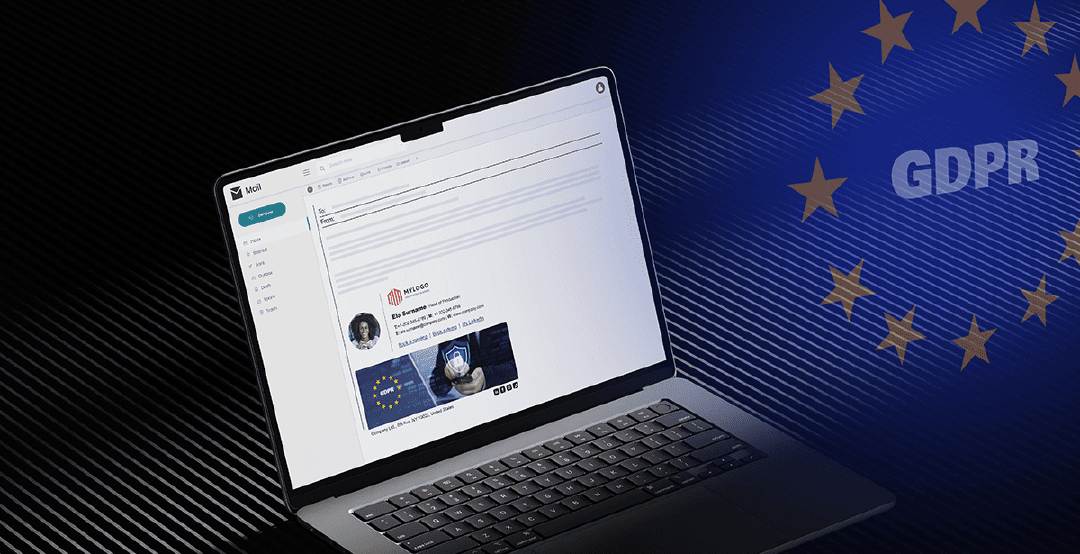Ensuring Compliance: Best Practices for Email Signatures and Disclaimer Under GDPR
 regulation-complient email signature example 2025
regulation-complient email signature example 2025
Regulation-Compliant Email Signatures: What You Need to Know
Ensuring that your organization’s email signatures comply with relevant regulations is vital for legal compliance and maintaining professionalism. This involves understanding the legal requirements for email signatures and the appropriate use of banners within them.
1. Mandatory Information in Email Signatures
In many European countries, businesses are legally required to include specific information in their email signatures to comply with regulations such as the EU’s eCommerce Directive. While the General Data Protection Regulation (GDPR) focuses on data protection and privacy, it does not explicitly dictate the content of email signatures. However, including comprehensive information can enhance transparency and support compliance with various legal frameworks.
Required or strongly recommended fields:
- Full legal entity name (as registered)
- Company registration number
- Registered business address
- VAT ID (if applicable)
- Sender’s full name and job title
- Direct contact information (email, phone number)
- Link to the company’s privacy policy
- Legal disclaimer (confidentiality notice, liability, or regulatory disclosures depending on your industry)
- Disclaimer: Right to Disconnect
Including these details ensures transparency and aids in legal compliance across various jurisdictions.
2. Use of Banners in Email Signatures
Banners in email signatures can effectively promote brand content, drive traffic, or share updates. However, it’s crucial to distinguish between informational content and direct marketing to comply with regulations:
✔️ Acceptable Banner Usage (Branding & Information)
Banners used for non-commercial purposes are generally compliant, especially when the email itself is part of a legitimate business communication. These include:
- Announcing upcoming webinars, demos, trade shows, or public events
- Sharing links to recent blog posts, case studies, or whitepapers
- Promoting internal initiatives or brand messaging (e.g., CSR, company values)
- Company news and press coverage
- Informational banners for client portals, system upgrades, or service changes
These banners are considered informational and brand-supporting rather than direct advertising. They do not require explicit opt-in as long as the email was sent under a lawful basis for communication (e.g., a customer or business contact).
❌ Banners That May Violate GDPR (Direct Marketing)
If your banner includes clear promotional language or calls to purchase, it likely qualifies as direct marketing. Examples include:
- “Buy Now for $99.99”
- “Limited-Time Offer - 50% Off This Week Only”
- “Click Here to Purchase”
- “Subscribe Now for Exclusive Deals”
Under regulations like the ePrivacy Directive, sending direct marketing communications requires prior consent from the recipient. Including such marketing messages in emails to recipients who haven’t opted in can violate these rules and put your organization at risk.
3. How to Ensure Signature Compliance
 How to Ensure Signature Compliance
How to Ensure Signature Compliance
Managing legally compliant email signatures across an entire organization manually is inefficient and error-prone. That’s where a solution like AdSigner makes a big difference.
To ensure your email signatures comply with regulations:
➔ Standardize Email Signatures
Update legal disclaimers, privacy links, and banners across your entire organization from one centralized dashboard - ensuring every employee stays compliant.
➔ Implement dynamic templates with legal support
Create department-specific templates that automatically include required disclaimers or legal text based on role, region, or industry.
➔ Ensure secure image hosting
All images, including banners, are hosted by AdSigner-ensuring no bulky attachments are sent with your emails, keeping inboxes clean and compliant.
➔ Control banner usage
Easily manage which banners are active, for which departments, and ensure banner communication is fully compliant by using informational, brand-focused banners only.
➔ Audit trails & version control
Keep a history of changes for legal or internal audits, and ensure that all previous versions of signatures are traceable and accountable.
4. Best practices for email signature compliance
To sum up, here are a few best practices to follow:
- Include full legal company info in all signatures
- Add a link to your privacy policy
- Standardize signatures across departments
- Use banners for branding, not for direct selling - unless consent is given
- Regularly review and update signatures as regulations or company details change
Conclusion
Email signatures are often underestimated, but they’re a critical part of your compliance strategy. With laws like GDPR requiring transparency and consent in all communications, your signature needs to do more than just look good - it needs to follow the rules.
With AdSigner, you can ensure every email your team sends is not only professional and on-brand, but also compliant and secure.
- Want to make sure your banners and email signatures meet GDPR standards?
- Talk to our team to get started with AdSigner today.
- Let’s help you eliminate signature-related compliance risks - book a demo


